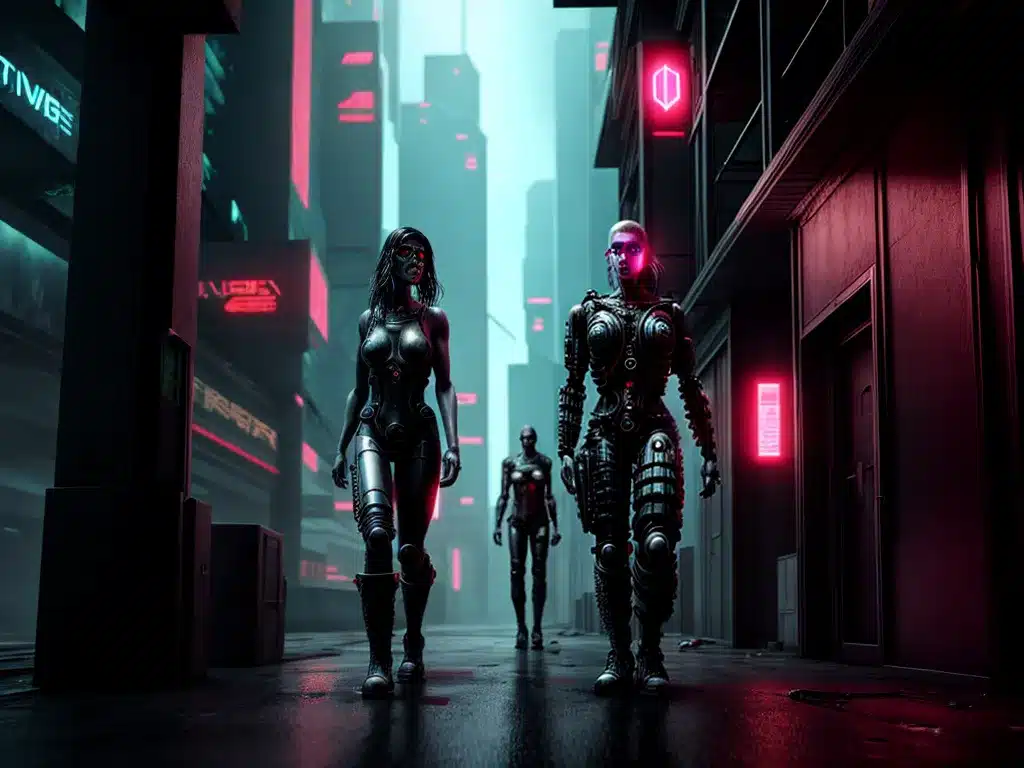
Introduction
The cyberpunk genre combines dystopian futures with advanced technology to create dark yet fascinating fictional worlds. As a creator, I aim to build immersive cyberpunk settings through carefully crafted visuals that convey a sense of gritty futurism. In this article, I will provide an in-depth guide to constructing a compelling cyberpunk universe using visual elements like architecture, technology, characters, and color palettes. By the end, you’ll have the tools to envision your own neo-noir science fiction environment.
Defining Cyberpunk and Dystopia
Before diving into the visual components, it’s important to understand the core themes and attitudes of cyberpunk. This subgenre combines dystopian fears about society’s future with advanced technology like cybernetics, artificial intelligence, and virtual reality.
Some key cyberpunk characteristics include:
-
High tech, low life – Futuristic technology exists, but it’s unevenly distributed and most people still live in squalor.
-
Gritty urban landscapes – Stories take place in sprawling, dark, crowded megacities with a grungy, worn-down aesthetic.
-
Corporate control – Powerful corporations supersede government control and individual freedom.
-
Transhumanism – People enhance themselves with cybernetic implants and genetic engineering.
-
Hacker counterculture – Outlaw computer hackers fight authoritarian systems and corporations.
-
Moral ambiguity – Traditional ethics are obsolete and the distinction between “good” and “bad” is blurred in the dark future setting.
The dystopian aspect creates an atmosphere of social decay, authoritarian rule, and pervasive technology threatening humanity. As the creator, I want to leverage these cyberpunk themes to craft a compelling science fiction vision.
Developing a Unique Architectural Aesthetic
The cityscapes and buildings in a cyberpunk world establish the atmosphere and visual identity. As the creator, I aim to design structures that feel futuristic while remaining grounded in urban decay.
Blending Old and New
Combining dated, worn-down buildings with high-tech additions creates a lived-in retro-futuristic look. For example, integrating holographic screens and neon lights into dilapidated towers conveys a sense of history and technological advancement. Using retro design elements like brick, concrete, and exposed pipes also links to the past.
Verticality and Density
To emphasize corporate domination, I envision dense, vertically stacked cityscapes. Clustering towers together with limited ground space conveys a claustrophobic, overpopulated urban environment. Focusing on height over sprawl highlights the inequality between elite sky cultures and the crowded city depths.
Incorporating Asian Influences
As cyberpunk originated from 1980s visions of Japan’s economic boom, incorporating East Asian urban design references helps establish authenticity. For instance, adding pagoda-like facades, dragon ornamentation, and rising sun motifs to buildings nods to Asian architecture within a futuristic melting pot city.
Advanced Technologies
Integrating plausible but imaginative technologies is crucial for realizing a cyberpunk environment. As the creator, I conceptualize gadgets, augmentations, and artificial intelligence that feel ahead of our time but still grounded in real technological advancement.
Cybernetic Augmentations
A key aspect of cyberpunk transhumanism is enhancing the human body with technology. I envision people augmenting themselves with cybernetic implants like brain chips, artificial limbs, and synthetic organs to gain superhuman abilities. Detailed technical designs and branding for these fake products make them seem tangible.
Next-Gen Interfaces
To portray advanced computing, I imagine seamless graphical interfaces where data and holographic screens can be accessed instantly through hand motions and eye-tracking. Exploring evolving input methods like gesture, voice and even brain-controlled interaction conveys sophisticated, omnipresent technology.
Artificial Intelligence
Sophisticated AI should play an integral societal role, including service droids, self-driving vehicles, robotic security forces and computer systems managing infrastructure. I aim to make these AI entities feel smart yet unsettling, avoiding tropes like clumsy helper robots.
Gritty Fashion and Costumes
Character wardrobes also significantly contribute to the cyberpunk atmosphere. As the creator, I conceptualize outfits mixing subcultures, makeshift gear and wearable tech.
Punk and Counterculture Influences
Drawing inspiration from punk, goth and underground movements creates a rebellious anti-establishment aesthetic. Elements like mohawks, piercings, studded leather, torn denim and band logos portray characters rejecting mainstream conformity.
Improvised Streetwear
Many can’t afford mass-produced gear and must improvise. Layers of ragged, mismatched clothes with makeshift straps and pouches add a handcrafted DIY edge. I also envision augmenting ordinary items like gas masks, goggles and combat boots into menacing high-fashion.
Functional Wearable Tech
Cyberware like goggles, headphones and backpacks with visible gadgets make technology feel integrated and purposeful. Designing unique brands and logos for these fictional products grounds them in reality. For instance, a character could wear a jacket with a paramilitary android company patch.
Color Palettes and Lighting
The color grading and lighting effects set the visual tone and atmosphere. As the creator, I use colors and illumination strategically to convey the cyberpunk genre.
Neon Accents
Vibrant neon signs, holograms and strips integrated into characters and architecture provide striking accents against dark environments. Using pink, cyan, green and other bold complementary colors makes the neon pop.
Dark, Desaturated Hues
Monochrome, slightly desaturated color palettes portray grungy urban decay while allowing brighter colors to stand out. Dark environments lit by glowing screens and vibrant holograms create visual drama and contrast.
Strong Light Sources
Spotlights, vehicle headlights, police searchlights, glowing signs and holograms pierce the darkness to create chiaroscuro lighting effects with sharp highlights and shadows. This feels naturally moody rather than artificially filtered.
Final Thoughts
Constructing compelling cyberpunk worlds requires balancing retro and futuristic elements with urban grittiness. Through detailed architectural concepts, plausible advanced technology, lived-in costumes and strategic color use, I aim to craft immersive dystopian science fiction settings that feel both fantastical and believable. The dark future awaits!












